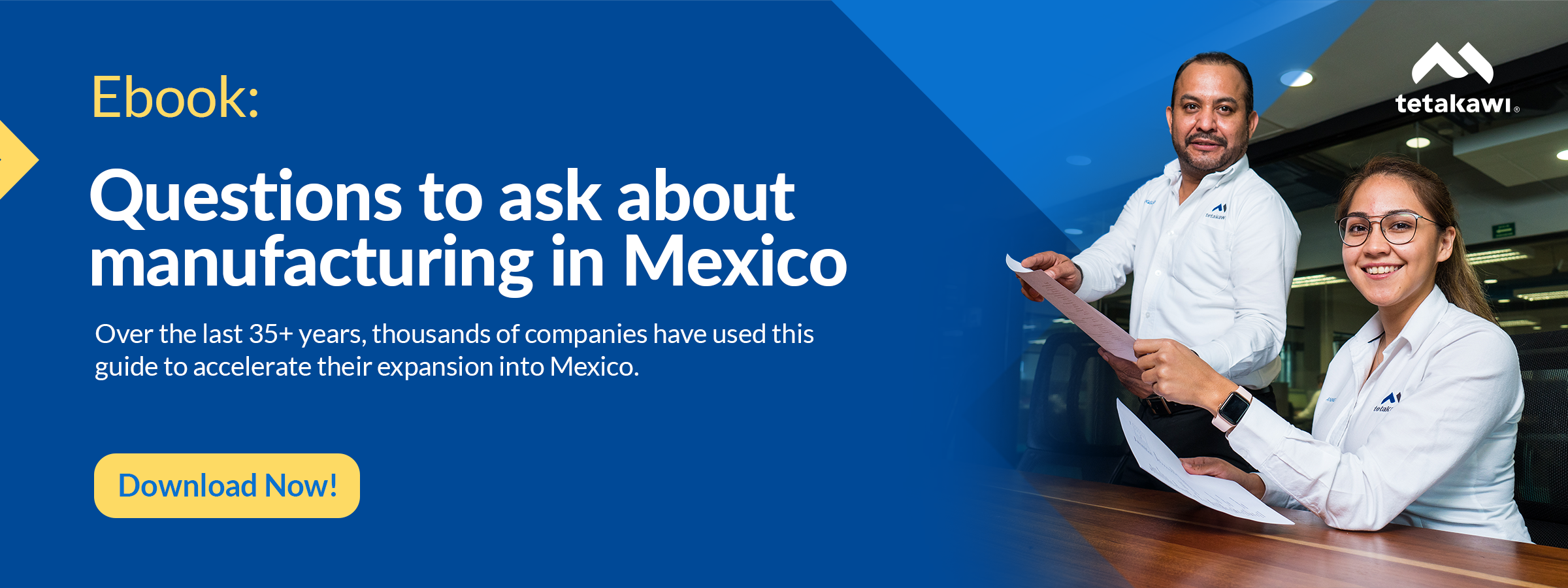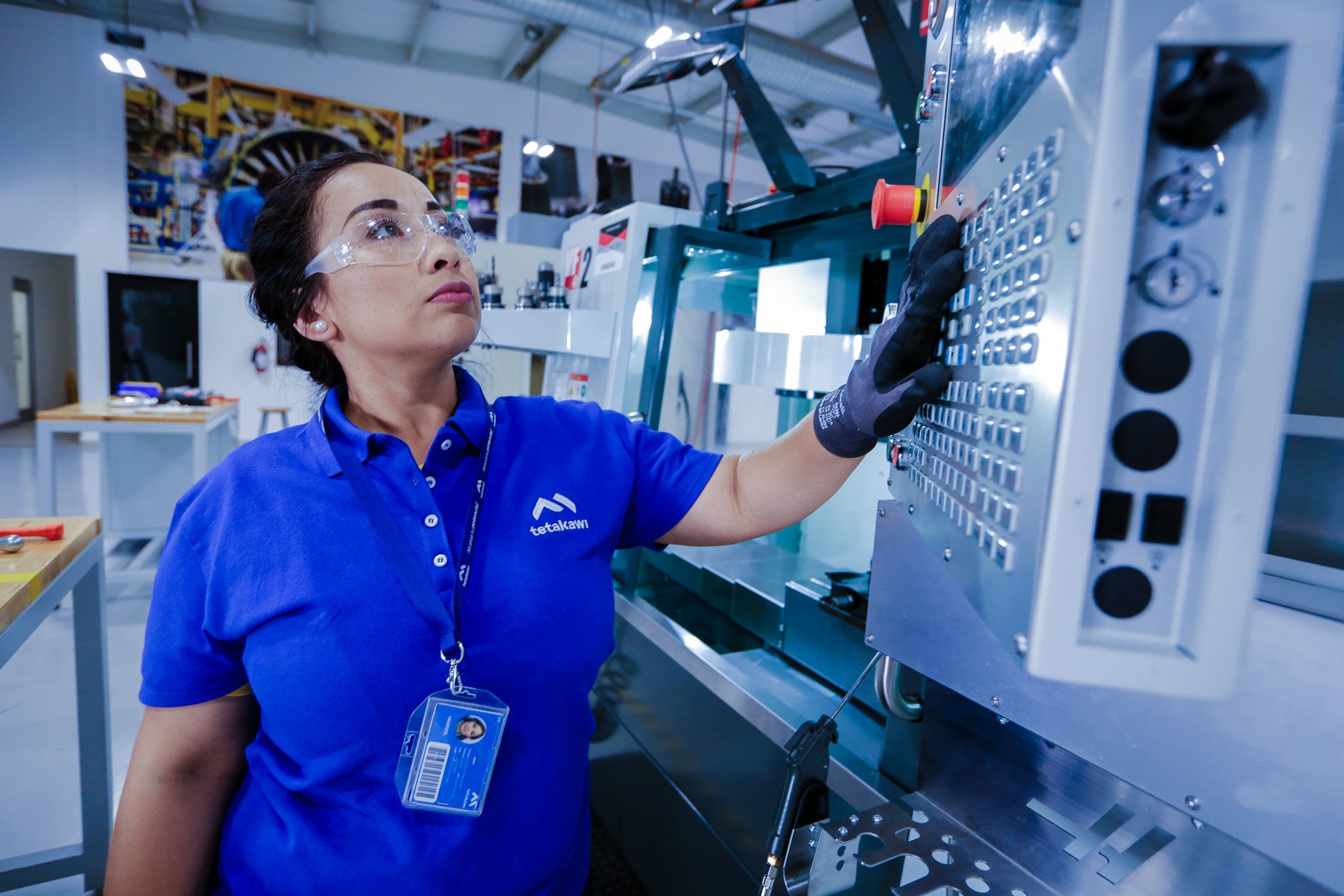If you’re thinking about manufacturing in Mexico, clarity is your most valuable asset.
Executives today are under pressure to rebalance global supply chains, scale capacity closer to home, and regain control of production. But many are approaching Mexico with outdated assumptions, treating it as a low-cost substitute for China, or assuming that contract manufacturing will solve their problems overnight.
It won’t.
Mexico is not a direct substitute for China-style contract manufacturing. It is not a uniformly low-cost labor market. And success here is not automatic.
This guide is designed to help you cut through the noise. Whether you’re:
-
A C-level executive exploring Mexico for the first time,
-
Struggling to scale in saturated regions like Tijuana or Juarez,
-
Or trying to re-integrate manufacturing capabilities you once offshored to China,
...you’ll walk away with a clear understanding of how Mexico works, what it takes to succeed, and how to think about the options strategically.
Why Companies Are Manufacturing in Mexico in 2025
The context is clear: companies can’t find labor at home, and the go-to overseas model is no longer working. That’s why executives are turning to Mexico, not just out of cost pressure, but because they need a reset. A model that gives them control, access, and long-term resilience.
- The U.S. Labor Bottleneck: According to the National Association of Manufacturers, average annual compensation in U.S. manufacturing exceeds $100,000, and it’s still not enough to close the gap. With 482,000 open manufacturing jobs as of February 2025, the United States is operating at a structural disadvantage: too few people want to work in manufacturing, and too many experienced workers are aging out. Even in places with favorable tax policy or strong infrastructure, labor is the bottleneck.
- The China Decoupling Dilemma: Geopolitical risk, IP concerns, and the slow unraveling of China’s labor cost advantage have accelerated interest in alternatives. But companies that once abandoned production capabilities to focus on design and distribution are now discovering a hard truth: China-style contract manufacturing doesn’t exist at the same scale in North America.
- Why Mexico Stands Out: Mexico’s advantages in 2025 are rooted in demographics, location, and integration:
- Young, growing workforce: Average age of 29, with over 91% of the population under 65.
- North American supply chain integration: Mexico is tied into the same standards, customers, and logistics flows as the U.S. and Canada.
- Shared time zones and culture: Overlapping hours and cultural alignment make oversight and collaboration significantly easier.
- Tariff resilience: Thanks to USMCA, Mexican manufacturing remains shielded from many of the tariff fluctuations plaguing U.S.-China trade.
But realizing those advantages requires far more than choosing a country, it demands choosing the right model, the right location, and the right partner.
Succeeding in Mexico Starts With Your Operating Model
Mexico works, but only if you approach it with the right structure. This isn’t about replicating a China-style supply chain. It’s about building a North American operation that balances control, cost, and speed in a way that fits your long-term strategy.
That begins with your entry model.
There is no one-size-fits-all approach. Mexico offers several viable ways to establish a manufacturing footprint, but each comes with trade-offs in control, compliance, risk, and scalability.
What matters most is aligning your model to your goals.
Some companies want simplicity and speed. Others prioritize full control and long-term ownership. Many fall somewhere in between. Understanding these paths, and the real-world implications of each, is the first step to building a manufacturing operation that performs.
Let’s walk through the five primary entry strategies for manufacturing in Mexico:
- Contract Manufacturing: Outsourcing your production to a third party that owns the facility, labor, and processes.
- Pros: Low upfront investment, fast setup, no legal or HR obligations.
- Cons: Limited control, potential IP risk, less flexibility when scaling.
- Key Takeaway: Ideal for transactional production, but it breaks down when control and scale matter.
- Joint Venture: A formal partnership with a local company to share ownership, investment, and operations.
- Pros: Shared cost/risk, built-in local knowledge.
- Cons: Misaligned priorities, complex governance, hard to unwind.
- Key Takeaway: Works when partners align perfectly… but that’s rare.
- Acquisition: Buying an existing manufacturing facility or company.
- Pros: Immediate footprint, inherited workforce and vendors.
- Cons: Integration issues, legacy baggage, hidden liabilities.
- Key Takeaway: Quick entry, but only if you know what you’re buying.
- Standalone Entity: Creating your own legal entity and managing all operations internally.
- Pros: Full control, long-term autonomy, asset ownership.
- Cons: Legal hurdles, long timeline, high internal burden.
- Key Takeaway: Great for companies with scale, expertise, and patience.
- Shelter Services: Operating under a third-party’s legal structure to reduce risk.
- Pros: Fast launch, admin and compliance handled.
- Cons: Varying quality and transparency.
- Key Takeaway: The best option for many, just be sure your shelter is the right fit. No two shelter service providers are alike.
Entry Strategy Comparison: Side-by-Side
Now, depending on what brought you to this guide, you may be weighing these options through different lenses:
-
If you're focused on speed and simplicity, the shelter model is often the most practical path forward.
-
If you're chasing a hands-off, transactional setup like in China, contract manufacturing may seem appealing, but it rarely delivers at scale in Mexico.
-
If long-term control is your priority, a standalone entity offers it, just be prepared for more time, cost, and internal lift.
Here’s what we’ve learned from watching hundreds of companies enter Mexico:
-
Contract manufacturing is often the default expectation, but hard to find,
-
The companies that succeed most often choose either shelter or standalone, with time and internal bandwidth usually being the deciding factors. But when it comes to launch speed and operating cost, shelter often wins out as the faster, leaner path, especially for first-time entrants.
Use this chart to quickly compare the trade-offs:
| Entry Model | Speed to Launch | Production Control | Legal Complexity | Best Fit For |
|---|---|---|---|---|
| Contract Mfg | Fast | Low | Low | Short-term, transactional needs |
| Joint Venture | Medium | Shared | High | Strategic partnerships |
| Acquisition | Medium | Medium | High | Quick presence via acquisition |
| Standalone | Slow | Full | Very High | Long-term control and ownership |
| Shelter | Fast | Full | Low | Scalable, low-risk setup with control |
As the chart shows, shelter and standalone offer the most control, but differ sharply in speed, complexity, and internal lift. Once you understand the right model for your business, geography becomes your next strategic lever.
From “How” to “Where”: Choosing the Right Location in Mexico
Once you’ve determined how to operate in Mexico, the next logical question is where. And this is where many companies run into trouble. Mexico is not a monolith. It’s a large, diverse country with significant variation across labor markets, infrastructure, and operating environments.
Choosing the wrong region can be the difference between a launch that scales, and one that stalls.
This section offers a panoramic overview of the five general manufacturing regions in Mexico, followed by a micro-level look at what companies are doing on the ground in 2025.
Overview of Mexico's Five Main Manufacturing Regions:
| Region | Key Cities | Distance from U.S. | Key Features |
|---|---|---|---|
| Border | Tijuana, Juarez, Reynosa, Mexicali | 0–100 miles | Deep vendor networks, but high costs and labor saturation |
| Northeast | Monterrey, Saltillo, Torreón | 100–300 miles | Industrial powerhouse, but costly and congested |
| Northwest | Hermosillo, Guaymas, Mazatlán | 300–600 miles | Emerging labor markets, lower turnover, attractive wages |
| Bajío | Querétaro, León, San Luis Potosí | 300–500 miles | Balanced ecosystem with growing OEM/auto footprint |
| Central | Mexico City, Toluca, Puebla, Guadalajara | 400+ miles | Larger labor pool, but intense competition and complexity |
Of course, companies don’t operate in regions of Mexico, they operate in cities. And when you zoom in, the variation becomes even more pronounced.
On-the-Ground Realities: What We're Seeing in 2025
Based on our real-world conversations with executives, here’s where we’re seeing the most traction, and the most friction, in 2025. These are the cities companies are either actively targeting or reassessing:
-
Tijuana continues to draw interest due to its proximity to California, but labor costs and turnover are pushing companies to explore alternatives.
-
Monterrey remains Mexico’s industrial capital, but congestion and rising wages are creating friction, especially for companies seeking to scale.
-
Hermosillo is gaining traction as a lower-cost, lower-turnover alternative to Tijuana, especially for companies that need experienced operators but are struggling with retention.
- Saltillo is often considered an answer to Monterrey’s saturation. It offers a deep, skilled labor pool and lower costs, though availability can be constrained depending on the time of year.
-
Mazatlán is emerging as an option for companies who can train but can’t afford to lose employees. Companies in advanced manufacturing like CPP have already made the move, valuing labor availability, cost, and retention over immediate scale..
Comparative Metrics: Labor and Real Estate for Manufacturers in Mexico
Let’s break down two key factors companies evaluate when selecting a city: manpower and real estate.
If you’ve read this far, you already understand that Mexico is not a single labor market. Cities differ not only in demographics, but in labor intensity, experience levels, and cost structures. What works in Tijuana may not work in Mazatlán. The opposite is also true.
Use the following tables to get a grounded understanding of what labor supply and facility costs look like today in five cities we’re most frequently asked about.
Manpower Comparison of Manufacturing Cities in Mexico
Labor isn’t just about wages, it’s about availability, skill, and retention. Here’s how the current landscape compares across five top cities.
| City | Economically Active Population | % Employed in Manufacturing | Unskilled Wage (USD/hr) |
|---|---|---|---|
| Tijuana | 885,970 | 24% | $7.59 |
| Hermosillo | 445,559 | 15% | $5.27 |
| Mazatlán | 256,545 | 4% | $4.84 |
| Monterrey | 2,177,302 | 23% | $6.63 |
| Saltillo | 495,537 | 39% | $6.22 |
Industrial Real Estate Comparison by City in Mexico(Q1 2025)
Real estate costs and availability can determine your launch timeline and long-term expansion potential. Here's where things stand today.
| City | Avg. Rent (USD/sf/m) | Vacancy Rate |
|---|---|---|
| Tijuana | $0.79 | 2.73% |
| Hermosillo | $0.61 | N/A |
| Mazatlán | $0.60 | N/A |
| Monterrey | $0.65 | 2.73% |
| Saltillo | $0.66 | 0.67% |
Interpreting the Data: Connecting Labor and Real Estate for Smarter Mexico Site Selection
Labor and real estate don’t exist in separate silos, they interact. Understanding how these factors converge is what separates a good location from a great one. Cities with the lowest wages often have lower industrial activity, and therefore more available space, but that doesn’t always mean they’re the best fit.
Bottom line? Ask yourself not just “Where can I hire today?” but “Where will my operation still be cost-effective and scalable three years from now?”
For a more detailed breakdown of full-fringed wages for manufacturing in Mexico, click on this link.
From Insight to Action: A Due Diligence Playbook for Expanding into Mexico
At this point, you understand how Mexico works, the paths to enter, and the regional variables that matter. But insight isn’t action. The companies that succeed in Mexico follow a clear, intentional diligence process, one that starts with getting grounded in the facts, not chasing assumptions or mirroring competitors.
Below is a framework to help you move forward strategically, with a few caution signs to watch for at each stage:
1. Define Your Strategic Objectives
-
What problem are you solving by manufacturing in Mexico? Cost? Capacity? Control?
-
What are your must-haves vs. nice-to-haves (e.g., timeline, headcount, proximity to border)?
Warning Sign: Vague goals like "just lower costs" often lead to misalignment later. Be specific about what success looks like.
2. Validate the Labor Market with Real Data
-
Understand labor availability in 1-3 shortlisted cities
-
Use third-party wage benchmarks and turnover data, not just local anecdotes
Warning Sign: Data from local development councils (EDCs) can be helpful, but some may have a promotional bias. Always validate with multiple sources.
3. Pressure-Test Your Timeline
-
Are you under pressure to launch quickly? If so, rule out models or locations with long setup cycles
-
Consider whether your organization has the internal capacity to manage hiring, legal compliance, and construction
Warning Sign: Underestimating ramp-up time is one of the most common mistakes. Expect at least 6-12 months for a standalone facility.
4. Align Internal Stakeholders
-
Ensure buy-in from finance, operations, legal, and supply chain before site visits
-
Misalignment between corporate and operations teams delays decisions and kills momentum
Warning Sign: A COO and CFO with different goals is a red flag. Get on the same page early.
5. Visit Shortlisted Locations
-
Use your initial research to structure productive site visits. Don’t just tour buildings, meet HR leaders, talk to employees, and understand day-to-day life
Warning Sign: Falling in love with a building can blind you to workforce realities. The site is secondary to the labor market.
The Final Word: Execution Matters in Mexico
Mexico is full of promise, but success here isn’t guaranteed. The companies that win are the ones who treat this as an operational investment, not a procurement exercise.
At Tetakawi, we don’t just advise on strategy. We operate the infrastructure that makes it real. From full-scale manufacturing communities to shelter services that simplify setup, we’re the execution partner behind some of the most successful launches in Mexico.
If you're ready to move from interest to action, we're here to help you build something that lasts. Contact us today to start executing upon your Mexico strategy.
Subscribe
Sign up and stay informed with tips, updates, and best practices for manufacturing in Mexico.






